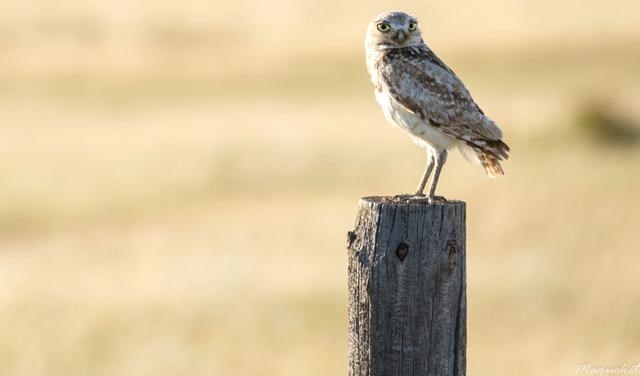(Photo by Tammy Thomas)
This is the time of year when the endangered Burrowing Owl returns to the Prairies after a long migration from its wintering grounds in Texas and Mexico. But it’s no time to rest. After migration, the owls are busy! They are starting the mating process, finding a home, and laying and incubating their eggs.
Burrowing Owls are identifiable by their small size, approximately nine inches tall, similar to the size of a robin, and their light and dark brown mottled plumage with white spots. They appear as though they are walking on stilts, due to their long featherless legs. They have a round head, with large yellow eyes, and white ‘eyebrows’.
Unlike some other owl species, they are very active during the day, especially in the spring when gathering food for their young. During the nesting season, male Burrowing Owls can often be seen next to their burrows or on nearby fenceposts while the female incubates the eggs down in the burrow.
Nesting is not always easy or successful. Burrowing Owls have many predators including hawks, foxes and even house cats, and finding a suitable nesting spot can be challenging.
According to Nature Saskatchewan’s Operation Burrowing Owl coordinator, Kaytlyn Burrows, “Burrowing Owls love open areas of short grasslands with vacant burrows for nesting. Since they cannot dig their own burrows, Burrowing Owls rely on badgers and Richardson’s Ground Squirrels, a.k.a. gophers, to do the dirty work for them. The owls also coexist with cattle very well and benefit from grazing, which keeps the grass short enough for the owls to spot their predators.”
There are many advantages to having these owls on a producer’s land, especially the free pest control. “Burrowing Owls eat huge numbers of insects, mice, voles, and grasshoppers,” said Burrows. “One nest of Burrowing Owls can consume 1,000 or more rodents in a single season.”
Nature Saskatchewan runs the voluntary stewardship program Operation Burrowing Owl, and is currently working with just over 350 landowners and managers to protect and enhance Burrowing Owl habitat and monitor Burrowing Owl population numbers. “Nature Saskatchewan is very fortunate to have so many passionate landowners participating in the program and keeping a look-out for Burrowing Owls,” said Burrows. Operation Burrowing Owl records sightings to help determine the population trend and distribution of the Burrowing Owl throughout Saskatchewan. The information can then be used towards efforts to conserve and restore the habitat and population of these charismatic birds.
“Without the voluntary efforts of landowners, land managers, and the general public, recovery of this unique prairie owl would not be possible,” said Burrows. She also encourages the public to report any sighting of a Burrowing Owl by calling Nature Saskatchewan’s toll-free line, 1-800-667-HOOT (4668).
“As residents of Saskatchewan, we can all work together to help this amazing species survive and thrive.”
Personal and sighting information is never shared without permission.




